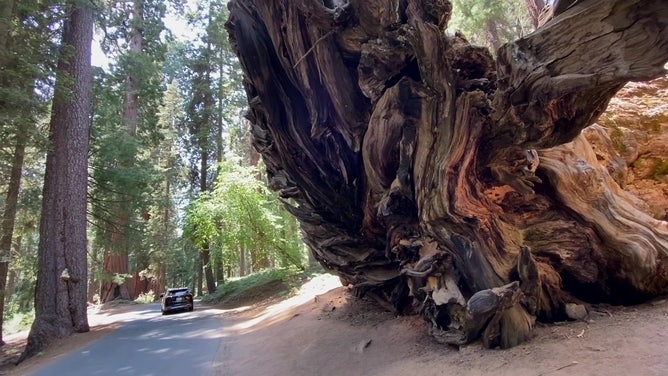Lessons from past wildfires give hope to saving world's largest trees
Wildfires have threatened some the world's oldest trees the past two years in a row
Sequoia National Park 2020 wildfire worst since 1200's: scientists
FOX Weather multimedia journalist Robert Ray on the race to preserve ancient, giant trees for the state of California.
SEQUOIA NATIONAL PARK, Calif. – For the second year in a row, fire and ash spread across Sequoia National Park where ancient trees stand – some estimated to be nearly 3,000 years old.
To protect them, fire-resistant aluminum blankets were wrapped around the base of these giants.
"Just a year ago, thousands (of trees) were incinerated," said Christy Brigham with Sequoia-Kings Canyon National Park. "Unprecedented fire effects, Monarch Sequoia's being completely incinerated ... I cried; many of us cried."
It's a scene officials hope doesn't happen again with all they have learned.
"The fire burned so intensely because of the drought and because of absence of fire on the landscape in the last 130 years, that fire got off the ground and basically laddered its way up into the canopies of these trees," said Clay Jordan, Superintendent of Sequoia-Kings Canyon National Parks.

Sequoia National Forest
(FOX Weather)
In that sacred forest where the tallest and oldest trees in the world exist, park officials are concerned about excessive drought, the wildfires and an environment that just continues to keep changing.
Some of these giant trees are as tall as a 25-story building and wider than a two-lane road. Wildfires can benefit the lifecycle here, but recent blazes were different.
"So when a fire comes in, you can get logs and needles at the base of the tree," Brigham said. "Those burn, and they create an opening into the center of the tree and future fire then expand that opening. So you can actually end up with a tree this large that is completely hollow on the inside and is still alive and totally fine and live that way and live another 500 to 800 years."
The 2020 blaze in the park, called the Castle Fire, was estimated to be the worst since the late 1200s. Scientists know this because of the tree rings and char marks.
"So, now with the suppression of fire for so long combined with the drought now we have a situation where the fire burns so intensely it actually kills the sequoias," Jordan said.
Park officials want to increase controlled or prescription burns and mechanical thinning of some of the groves. They said the forest is too dense and worry about future infernos and the destruction they may cause.

Sequoia National Forest
(FOX Weather)
"These trees need fire, but it needs to be a small, healthy fire," Jordan said.
The Castle Fire cost over $100 million to fight, and some trees are actually still smoldering. The ecosystem has changed because of the violent and vast scorch.
"We love these trees," Brigham said. "We have protected almost all of them; we spent a century building parks, visiting them, caring for them, and now they are burning up in high-severity fire even though they are one of the most fire adapted species on Earth. So this is really a call to action for us as managers and all of us as people who love nature to make a change.
Among the trees that were threatened during the 2021 fire was the General Sherman, which is roughly 2,500 years old, has a base diameter of over 36 feet, and is the largest known living sequoia in the world.
For park officials, more wildfires are expected in the years ahead, but reducing stress on the forest with more strategic burns and thinning is their ultimate hope and goal to keep this natural treasure from going up in flames.
